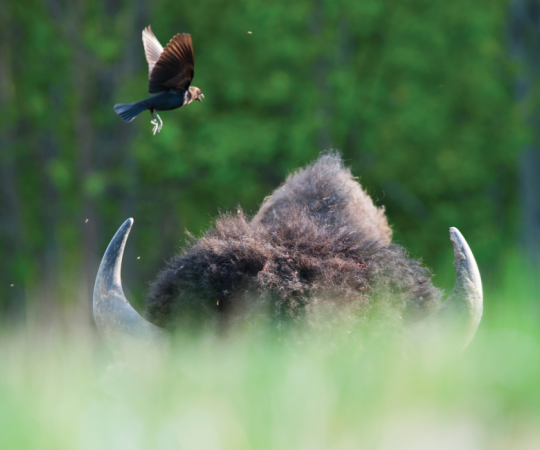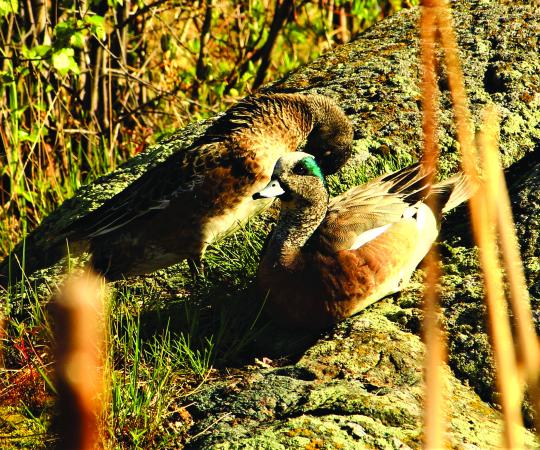If you’re hiking the north-side of a Yukon mountain on a hot summer day, keep an eye out for grizzlies. Unlike people, who pack away their parkas as soon as the cold dark days turn into long sunny nights, bears and other cold-adapted species can’t quite shed their thick coats (at least not the whole thing). It’s understandable then why the hibernators would want to avoid the heat of the sun while they’re busy eating everything they can get their claws on, gaining up to two pounds a day.
But despite the heat, chances are most animals wouldn’t trade the sunny days even if they could: The long daylight hours mean more time to hunt, forage and feast before winter. “Generally, there’s a lot of food for a short period of time and animals have adapted to take advantage of those windows,” says Thomas Jung, senior wildlife biologist with the Yukon Government.
Collared pikas—small mammals related to rabbits and hares—spend their summers harvesting vegetation from the alpine meadows of the Yukon and western NWT, making piles and storing them under rocks for the winter. “They really take to heart that saying, ‘Make hay while the sun shines,’” says Jung. “They’re busy making these piles because toward the end of the summer, they know the tide will turn in terms of the light regime and they make sure they’re safe and secure in their burrows.”
Yellowknife ornithologist Bob Bromley was on a research trip in the U.S. during a solar eclipse. As the sun moved behind the moon, the sky suddenly filled with birds and flocks of geese. They dove straight for the bushes on the ground as the moon covered the sun completely. “We were astounded,” says Bromley. “They thought it was night and then 10 minutes later they came right back out and started singing again.”
The length of daylight—or the photoperiod—is a key indicator for birds to know when to rest, when to migrate, when to become territorial and when to time their hunt.
Under the midnight sun, Bromley says birds barely sleep at all. If you listen closely, you can hear bird songs at pretty well all hours—the male’s way of enticing females and making his territory known.
“Birds have a peak in singing at a particular time of day, according to the species,” says Bromley. “Some start before dawn, others at dawn, and others right after. But when there is light, they’ll be active 24 hours a day.”
Thriving in the nightlife is a bat’s niche, says Jen Talerico. Along with Thomas Jung, Talerico tracked a colony of little brown bats living in a tower at the Watson Lake airport for her Master’s thesis through the University of Calgary. At the summer solstice, she watched the bats leave their roost around midnight and enter again around 1:40 a.m. By mid-August, that window expanded to 9:40 p.m. and 3:40 a.m.
Hunting and feeding is a tiring exercise for bats. In the south, they take breaks, hang up and digest, before heading back out to forage throughout the night. During Northern summers, there are so few hours of darkness for bats, their nights becomes a non-stop feeding frenzy. They rush ecosystems they would normally avoid and feast on the wide array of bugs available, including some their southern relatives would turn their noses up at.
Early on in the summer, with the fewest hours of darkness, the bats hunted spiders—something only seen before from bats in Alaska. They also stayed away from wide-open spaces. They flew close to fences and buildings at the airport and into wooded areas that offered more darkness and coverage. This tendency toward denser areas, Talerico hypothesized, accounted for the smaller mass and shorter wingspan among Northern bats, letting them navigate tight spaces.
With a short window for foraging, Northern bats are making the most of it. “Being out in the forest with the sun up, you can still hear the loons calling but you see bats flying and see everything going on,” says Talerico. “It’s a magical feeling for it to be night but light out, and to have all these night creatures out at the same time.”
A new look
A study of Eurasian reindeer found their eyes
change colour, from gold in the summer when
exposed to endless sunlight, to blue in the
winter when the days are dark.
The gold colour reflects light directly through the retina, while the deep blue colour scatters light through more photoreceptors in the retina, making it more sensitive. This affects acuity—reindeer are
able to see more in the dim winter, but their vision is less sharp. Nonetheless, this shift helps the species spot predators and food.
The light rule
The way light affects the circadian cycle and activity levels of diurnal and nocturnal animals is known as Aschoff’s Rule, after German physician and behavioural physiologist Jürgen Aschoff. The rule suggests light intake suppresses sleep and promotes activity among diurnal animals, and vice-versa for nocturnal animals. Constant bright light sees activity time in diurnal animals grow beyond rest time.









